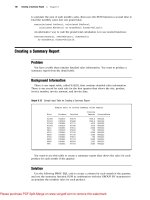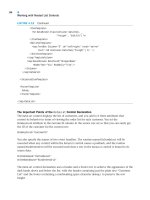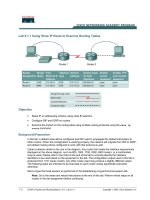SAS 9.1 SQL Procedure- P4
Bạn đang xem bản rút gọn của tài liệu. Xem và tải ngay bản đầy đủ của tài liệu tại đây (757.91 KB, 27 trang )
146 Creating a Summary Report
4
Chapter 6
to calculate the sum of each month’s sales, then uses the SUM function a second time to
total the monthly sums into one grand total.
sum(calculated JanTotal, calculated FebTotal,
calculated MarTotal) as GrandTotal format=dollar10.
An alternative way to code the grand total calculation is to use nested functions:
sum(sum(January), sum(February), sum(March))
as GrandTotal format=dollar10.
Creating a Summary Report
Problem
You have a table that contains detailed sales information. You want to produce a
summary report from the detail table.
Background Information
There is one input table, called SALES, that contains detailed sales information.
There is one record for each sale for the first quarter that shows the site, product,
invoice number, invoice amount, and invoice date.
Output 6.15 Sample Input Table for Creating a Summary Report
Sample Data to Create Summary Sales Report
Invoice
Site Product Invoice Amount InvoiceDate
-------------------------------------------------------
V1009 VID010 V7679 598.5 980126
V1019 VID010 V7688 598.5 980126
V1032 VID005 V7771 1070 980309
V1043 VID014 V7780 1070 980309
V421 VID003 V7831 2000 980330
V421 VID010 V7832 750 980330
V570 VID003 V7762 2000 980302
V659 VID003 V7730 1000 980223
V783 VID003 V7815 750 980323
V985 VID003 V7733 2500 980223
V966 VID001 V5020 1167 980215
V98 VID003 V7750 2000 980223
You want to use this table to create a summary report that shows the sales for each
product for each month of the quarter.
Solution
Use the following PROC SQL code to create a column for each month of the quarter,
and use the summary function SUM in combination with the GROUP BY statement to
accumulate the monthly sales for each product:
Please purchase PDF Split-Merge on www.verypdf.com to remove this watermark.
Practical Problem-Solving with PROC SQL
4
How It Works 147
proc sql;
title ’First Quarter Sales by Product’;
select Product,
sum(Jan) label=’Jan’,
sum(Feb) label=’Feb’,
sum(Mar) label=’Mar’
from (select Product,
case
when substr(InvoiceDate,3,2)=’01’ then
InvoiceAmount end as Jan,
case
when substr(InvoiceDate,3,2)=’02’ then
InvoiceAmount end as Feb,
case
when substr(InvoiceDate,3,2)=’03’ then
InvoiceAmount end as Mar
from work.sales)
group by Product;
Output 6.16 PROC SQL Output for a Summary Report
First Quarter Sales by Product
Product Jan Feb Mar
--------------------------------------
VID001 . 1167 .
VID003 . 5500 4750
VID005 . . 1070
VID010 1197 . 750
VID014 . . 1070
Note: Missing values in the matrix indicate that no sales occurred for that given
product in that month.
4
How It Works
This solution uses an in-line view to create three temporary columns, Jan, Feb, and
Mar, based on the month part of the invoice date column. The in-line view is a query
that
3
selects the product column
3
uses a CASE expression to assign the value of invoice amount to one of three
columns, Jan, Feb, or Mar, depending upon the value of the month part of the
invoice date column.
case
when substr(InvoiceDate,3,2)=’01’ then
InvoiceAmount end as Jan,
case
when substr(InvoiceSate,3,2)=’02’ then
InvoiceAmount end as Feb,
Please purchase PDF Split-Merge on www.verypdf.com to remove this watermark.
148 Creating a Customized Sort Order
4
Chapter 6
case
when substr(InvoiceDate,3,2)=’03’ then
InvoiceAmount end as Mar
The first, or outer, SELECT statement in the query
3
selects the product
3
uses the summary function SUM to accumulate the Jan, Feb, and Mar amounts
3
uses the GROUP BY statement to produce a line in the table for each product.
Notice that dates are stored in the input table as strings. If the dates were stored as
SAS dates, then the CASE expression could be written as follows:
case
when month(InvoiceDate)=1 then
InvoiceAmount end as Jan,
case
when month(InvoiceDate)=2 then
InvoiceAmount end as Feb,
case
when month(InvoiceDate)=3 then
InvoiceAmount end as Mar
Creating a Customized Sort Order
Problem
You want to sort data in a logical, but not alphabetical, sequence.
Background Information
There is one input table, called CHORES, that contains the following data:
Output 6.17 Sample Input Data for a Customized Sort
Garden Chores
Project Hours Season
----------------------------
weeding 48 summer
pruning 12 winter
mowing 36 summer
mulching 17 fall
raking 24 fall
raking 16 spring
planting 8 spring
planting 8 fall
sweeping 3 winter
edging 16 summer
seeding 6 spring
tilling 12 spring
aerating 6 spring
feeding 7 summer
rolling 4 winter
Please purchase PDF Split-Merge on www.verypdf.com to remove this watermark.
Practical Problem-Solving with PROC SQL
4
How It Works 149
You want to reorder this chore list so that all the chores are grouped by season,
starting with spring and progressing through the year. Simply ordering by Season
makes the list appear in alphabetical sequence: fall, spring, summer, winter.
Solution
Use the following PROC SQL code to create a new column, Sorter, that will have
values of 1 through 4 for the seasons spring through winter. Use the new column to
order the query, but do not select it to appear:
options nodate nonumber linesize=80 pagesize=60;
proc sql;
title ’Garden Chores by Season in Logical Order’;
select Project, Hours, Season
from (select Project, Hours, Season,
case
when Season = ’spring’ then 1
when Season = ’summer’ then 2
when Season = ’fall’ then 3
when Season = ’winter’ then 4
else .
end as Sorter
from chores)
order by Sorter;
Output 6.18 PROC SQL Output for a Customized Sort Sequence
Garden Chores by Season in Logical Order
Project Hours Season
----------------------------
tilling 12 spring
raking 16 spring
planting 8 spring
seeding 6 spring
aerating 6 spring
mowing 36 summer
feeding 7 summer
edging 16 summer
weeding 48 summer
raking 24 fall
mulching 17 fall
planting 8 fall
rolling 4 winter
pruning 12 winter
sweeping 3 winter
How It Works
This solution uses an in-line view to create a temporary column that can be used as
an ORDER BY column. The in-line view is a query that
3
selects the Project, Hours, and Season columns
Please purchase PDF Split-Merge on www.verypdf.com to remove this watermark.
150 Conditionally Updating a Table
4
Chapter 6
3
uses a CASE expression to remap the seasons to the new column Sorter: spring to
1, summer to 2, fall to 3, and winter to 4.
(select project, hours, season,
case
when season = ’spring’ then 1
when season = ’summer’ then 2
when season = ’fall’ then 3
when season = ’winter’ then 4
else .
end as sorter
from chores)
The first, or outer, SELECT statement in the query
3
selects the Project, Hours and Season columns
3
orders rows by the values that were assigned to the seasons in the Sorter column
that was created with the in-line view.
Notice that the Sorter column is not included in the SELECT statement. That causes
a note to be written to the log indicating that you have used a column in an ORDER BY
statement that does not appear in the SELECT statement. In this case, that is exactly
what you wanted to do.
Conditionally Updating a Table
Problem
You want to update values in a column of a table, based on the values of several
other columns in the table.
Background Information
There is one table, called INCENTIVES, that contains information on sales data.
There is one record for each salesperson that includes a department code, a base pay
rate, and sales of two products, gadgets and whatnots.
Output 6.19 Sample Input Data to Conditionally Change a Table
Sales Data for Incentives Program
Name Department Payrate Gadgets Whatnots
------------------------------------------------------------
Lao Che M2 8 10193 1105
Jack Colton U2 6 9994 2710
Mickey Raymond M1 12 6103 1930
Dean Proffit M2 11 3000 1999
Antoinette Lily E1 20 2203 4610
Sydney Wade E2 15 4205 3010
Alan Traherne U2 4 5020 3000
Elizabeth Bennett E1 16 17003 3003
Please purchase PDF Split-Merge on www.verypdf.com to remove this watermark.
Practical Problem-Solving with PROC SQL
4
Solution 151
You want to update the table by increasing each salesperson’s payrate (based on the
total sales of gadgets and whatnots) and taking into consideration some factors that are
based on department code.
Specifically, anyone who sells over 10,000 gadgets merits an extra $5 per hour.
Anyone selling between 5,000 and 10,000 gadgets also merits an incentive pay, but E
Department salespersons are expected to be better sellers than those in the other
departments, so their gadget sales incentive is $2 per hour compared to $3 per hour for
those in other departments. Good sales of whatnots also entitle sellers to added
incentive pay. The algorithm for whatnot sales is that the top level (level 1 in each
department) salespersons merit an extra $.50 per hour for whatnot sales over 2,000,
and level 2 salespersons merit an extra $1 per hour for sales over 2,000.
Solution
Use the following PROC SQL code to create a new value for the Payrate column.
Actually Payrate is updated twice for each row, once based on sales of gadgets, and
again based on sales of whatnots:
proc sql;
update incentives
set payrate = case
when gadgets > 10000 then
payrate + 5.00
when gadgets > 5000 then
case
when department in (’E1’, ’E2’) then
payrate + 2.00
else payrate + 3.00
end
else payrate
end;
update incentives
set payrate = case
when whatnots > 2000 then
case
when department in (’E2’, ’M2’, ’U2’) then
payrate + 1.00
else payrate + 0.50
end
else payrate
end;
title ’Adjusted Payrates Based on Sales of Gadgets and Whatnots’;
select * from incentives;
Please purchase PDF Split-Merge on www.verypdf.com to remove this watermark.
152 How It Works
4
Chapter 6
Output 6.20 PROC SQL Output for Conditionally Updating a Table
Adjusted Payrates Based on Sales of Gadgets and Whatnots
Name Department Payrate Gadgets Whatnots
------------------------------------------------------------
Lao Che M2 13 10193 1105
Jack Colton U2 10 9994 2710
Mickey Raymond M1 15 6103 1930
Dean Proffit M2 11 3000 1999
Antoinette Lily E1 20.5 2203 4610
Sydney Wade E2 16 4205 3010
Alan Traherne U2 8 5020 3000
Elizabeth Bennett E1 21.5 17003 3003
How It Works
This solution performs consecutive updates to the payrate column of the incentive
table. The first update uses a nested case expression, first determining a bracket that is
based on the amount of gadget sales: greater than 10,000 calls for an incentive of $5,
between 5,000 and 10,000 requires an additional comparison. That is accomplished
with a nested case expression that checks department code to choose between a $2 and
$3 incentive.
update incentives
set payrate = case
when gadgets > 10000 then
payrate + 5.00
when gadgets > 5000 then
case
when department in (’E1’, ’E2’) then
payrate + 2.00
else payrate + 3.00
end
else payrate
end;
The second update is similar, though simpler. All sales of whatnots over 2,000 merit
an incentive, either $.50 or $1 depending on the department level, that again is
accomplished by means of a nested case expression.
update incentives
set payrate = case
when whatnots > 2000 then
case
when department in (’E2’, ’M2’, ’U2’) then
payrate + 1.00
else payrate + 0.50
end
else payrate
end;
Please purchase PDF Split-Merge on www.verypdf.com to remove this watermark.
Practical Problem-Solving with PROC SQL
4
Solution 153
Updating a Table with Values from Another Table
Problem
You want to update the SQL.UNITEDSTATES table with updated population data.
Background Information
The SQL.NEWPOP table contains updated population data for some of the U.S.
states.
Output 6.21 Table with Updated Population Data
Updated U.S. Population Data
state Population
-----------------------------------------------
Texas 20,851,820
Georgia 8,186,453
Washington 5,894,121
Arizona 5,130,632
Alabama 4,447,100
Oklahoma 3,450,654
Connecticut 3,405,565
Iowa 2,926,324
West Virginia 1,808,344
Idaho 1,293,953
Maine 1,274,923
New Hampshire 1,235,786
North Dakota 642,200
Alaska 626,932
Solution
Use the following PROC SQL code to update the population information for each
state in the SQL.UNITEDSTATES table:
proc sql;
title ’UNITEDSTATES’;
update sql.unitedstates as u
set population=(select population from sql.newpop as n
where u.name=n.state)
where u.name in (select state from sql.newpop);
select Name format=$17., Capital format=$15.,
Population, Area, Continent format=$13., Statehood format=date9.
from sql.unitedstates;
Please purchase PDF Split-Merge on www.verypdf.com to remove this watermark.
154 How It Works
4
Chapter 6
Output 6.22 SQL.UNITEDSTATES with Updated Population Data (Partial Output)
UNITEDSTATES
Name Capital Population Area Continent Statehood
------------------------------------------------------------------------------------
Alabama Montgomery 4447100 52423 North America 14DEC1819
Alaska Juneau 626932 656400 North America 03JAN1959
Arizona Phoenix 5130632 114000 North America 14FEB1912
Arkansas Little Rock 2447996 53200 North America 15JUN1836
California Sacramento 31518948 163700 North America 09SEP1850
Colorado Denver 3601298 104100 North America 01AUG1876
Connecticut Hartford 3405565 5500 North America 09JAN1788
Delaware Dover 707232 2500 North America 07DEC1787
District of Colum Washington 612907 100 North America 21FEB1871
Florida Tallahassee 13814408 65800 North America 03MAR1845
How It Works
The UPDATE statement updates values in the SQL.UNITEDSTATES table (here
with the alias U). For each row in the SQL.UNITEDSTATES table, the in-line view in
the SET clause returns a single value. For rows that have a corresponding row in
SQL.NEWPOP, this value is the value of the Population column from SQL.NEWPOP.
For rows that do not have a corresponding row in SQL.NEWPOP, this value is missing.
In both cases, the returned value is assigned to the Population column.
The WHERE clause ensures that only the rows in SQL.UNITEDSTATES that have a
corresponding row in SQL.NEWPOP are updated, by checking each value of Name
against the list of state names that is returned from the in-line view. Without the
WHERE clause, rows that do not have a corresponding row in SQL.NEWPOP would
have their Population values updated to missing.
Creating and Using Macro Variables
Problem
You want to create a separate data set for each unique value of a column.
Background Information
The SQL.FEATURES data set contains information on various geographical features
around the world.
Please purchase PDF Split-Merge on www.verypdf.com to remove this watermark.
Practical Problem-Solving with PROC SQL
4
Solution 155
Output 6.23 FEATURES (Partial Output)
FEATURES
Name Type Location Area Height Depth Length
------------------------------------------------------------------------------------
Aconcagua Mountain Argentina . 22834 . .
Amazon River South America . . . 4000
Amur River Asia . . . 2700
Andaman Sea 218100 . 3667 .
Angel Falls Waterfall Venezuela . 3212 . .
Annapurna Mountain Nepal . 26504 . .
Aral Sea Lake Asia 25300 . 222 .
Ararat Mountain Turkey . 16804 . .
Arctic Ocean 5105700 . 17880 .
Atlantic Ocean 33420000 . 28374 .
Solution
To create a separate data set for each type of feature, you could go through the data
set manually to determine all the unique values of Type, and then write a separate
DATA step for each type (or a single DATA step with multiple OUTPUT statements).
This approach is labor-intensive, error-prone, and impractical for large data sets. The
following PROC SQL code counts the unique values of Type and puts each value in a
separate macro variable. The SAS macro that follows the PROC SQL code uses these
macro variables to create a SAS data set for each value. You do not need to know
beforehand how many unique values there are or what the values are.
proc sql noprint;
select count(distinct type)
into :n
from sql.features;
select distinct type
into :type1 - :type%left(&n)
from sql.features;
quit;
%macro makeds;
%do i=1 %to &n;
data &&type&i (drop=type);
set sql.features;
if type="&&type&i";
run;
%end;
%mend makeds;
%makeds;
Please purchase PDF Split-Merge on www.verypdf.com to remove this watermark.









